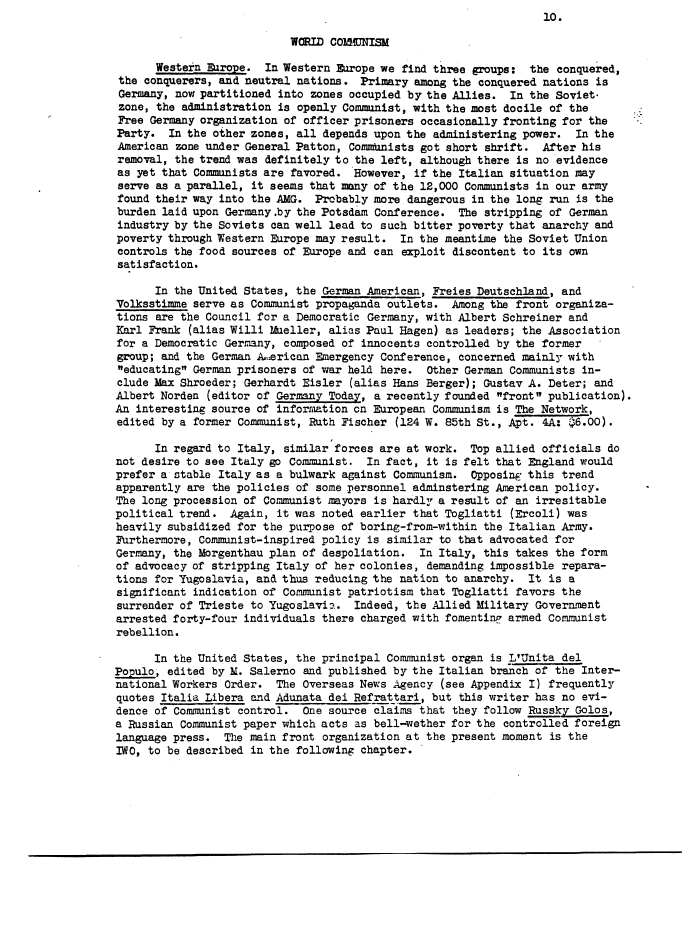 |
||||
 |
||||
| 10. WQRID COMMUNISM Western Europe. In Western Europe we find three groups: the conquered, the conquerors, and neutral nations. Primary among the conquered nations is Germany, nov; partitioned into zones occupied by the Allies. In the Soviet- zone, the administration is openly Communist, with the most docile of the Free Germany organization of officer prisoners occasionally fronting for the Party. In the other zones, all depends upon the administering power. In the American zone under General Patton, Communists got short shrift. After his removal, the trend was definitely to the left, although there is no evidence as yet that Communists are favored. However, if the Italian situation may serve as a parallel, it seems that many of the 12,000 Communists in our army found their way into the AMG. Probably more dangerous in the long run is the burden laid upon Germany .by the Potsdam Conference. The stripping of German industry by the Soviets can well lead to such bitter poverty that anarchy and poverty through VJestern Europe may result. In the meantime the Soviet Union controls the food sources of Europe and can exploit discontent to its own satisfaction. In the United States, the German American, Freies Deutschland, and Volksstimme serve as Communist propaganda outlets. Among the front organiza- tions are the Council for a Democratic Germany, with Albert Schreiner and Karl Frank (alias Willi Mueller, alias Paul Hagen) as leaders; the Association for a Democratic Germany, composed of innocents controlled by the former group; and the German African Emergency Conference, concerned mainly with "educating" German prisoners of war held here. Other German Communists in- clude Max Shroeder; Gerhardt Eisler (alias Hans Berger); Gustav A. Deter; and Albert Norden (editor of Germany Today, a recently founded "front" publication). An interesting source of information en European Communism is The Network, edited by a former Communist, Ruth Fischer (124 W. 85th St., Apt. 4A: $6.00). In regard to Italy, similar forces are at work. Top allied officials do not desire to see Italy go Communist. In fact, it is felt that England would prefer a stable Italy as a bulwark against Communism. Opposing this trend apparently are the policies of some personnel adminstering American policy. The long procession of Communist mayors is hardly a result of an irresitable political trend. Again, it was noted earlier that Togliatti (Ercoli) was heavily subsidized for the purpose of boring-from-xvithin the Italian Army. Furthermore, Communist-inspired policy is similar to that advocated for Germany, the Morgenthau plan of despoliation. In Italy, this takes the form of advocacy of stripping Italy of her colonies, demanding impossible repara- tions for Yugoslavia, and thus reducing the nation to anarchy. It is a significant indication of Communist patriotism that Togliatti favors the surrender of Trieste to Yugoslavia. Indeed, the Allied Military Government arrested forty-four individuals there charged with fomenting armed Communist rebellion. In the United States, the principal Communist organ is L'Unita del Populo; edited by M. Salerno and published by the Italian branch of the Inter- national Workers Order. The Overseas News Agency (see Appendix I) frequently quotes Italia Libera and Adunata dei Refrattari, but this writer has no evi- dence of Communist control. One source claims that they follow Russky Golos, a Russian Communist paper which acts as bell-^wether for the controlled foreign language press. The main front organization at the present moment is the IWO, to be described in the following chapter. |